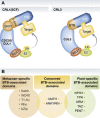The emerging family of CULLIN3-RING ubiquitin ligases (CRL3s): cellular functions and disease implications
- PMID: 23912815
- PMCID: PMC3770339
- DOI: 10.1038/emboj.2013.173
The emerging family of CULLIN3-RING ubiquitin ligases (CRL3s): cellular functions and disease implications
Abstract
Protein ubiquitylation is a post-translational modification that controls all aspects of eukaryotic cell functionality, and its defective regulation is manifested in various human diseases. The ubiquitylation process requires a set of enzymes, of which the ubiquitin ligases (E3s) are the substrate recognition components. Modular CULLIN-RING ubiquitin ligases (CRLs) are the most prevalent class of E3s, comprising hundreds of distinct CRL complexes with the potential to recruit as many and even more protein substrates. Best understood at both structural and functional levels are CRL1 or SCF (SKP1/CUL1/F-box protein) complexes, representing the founding member of this class of multimeric E3s. Another CRL subfamily, called CRL3, is composed of the molecular scaffold CULLIN3 and the RING protein RBX1, in combination with one of numerous BTB domain proteins acting as substrate adaptors. Recent work has firmly established CRL3s as major regulators of different cellular and developmental processes as well as stress responses in both metazoans and higher plants. In humans, functional alterations of CRL3s have been associated with various pathologies, including metabolic disorders, muscle, and nerve degeneration, as well as cancer. In this review, we summarize recent discoveries on the function of CRL3s in both metazoans and plants, and discuss their mode of regulation and specificities.
Conflict of interest statement
The authors declare that they have no conflict of interest.
Figures



References
-
- Amit S, Ben-Neriah Y (2003) NF-kappaB activation in cancer: a challenge for ubiquitination- and proteasome-based therapeutic approach. Semin Cancer Biol 13: 15–28 - PubMed
-
- Angers S, Thorpe CJ, Biechele TL, Goldenberg SJ, Zheng N, MacCoss MJ, Moon RT (2006) The KLHL12-Cullin-3 ubiquitin ligase negatively regulates the Wnt-beta-catenin pathway by targeting Dishevelled for degradation. Nat Cell Biol 8: 348–357 - PubMed
-
- Azizieh R, Orduz D, Van Bogaert P, Bouschet T, Rodriguez W, Schiffmann SN, Pirson I, Abramowicz MJ (2011) Progressive myoclonic epilepsy-associated gene KCTD7 is a regulator of potassium conductance in neurons. Mol Neurobiol 44: 111–121 - PubMed
Publication types
MeSH terms
Substances
LinkOut - more resources
Full Text Sources
Other Literature Sources
Molecular Biology Databases

